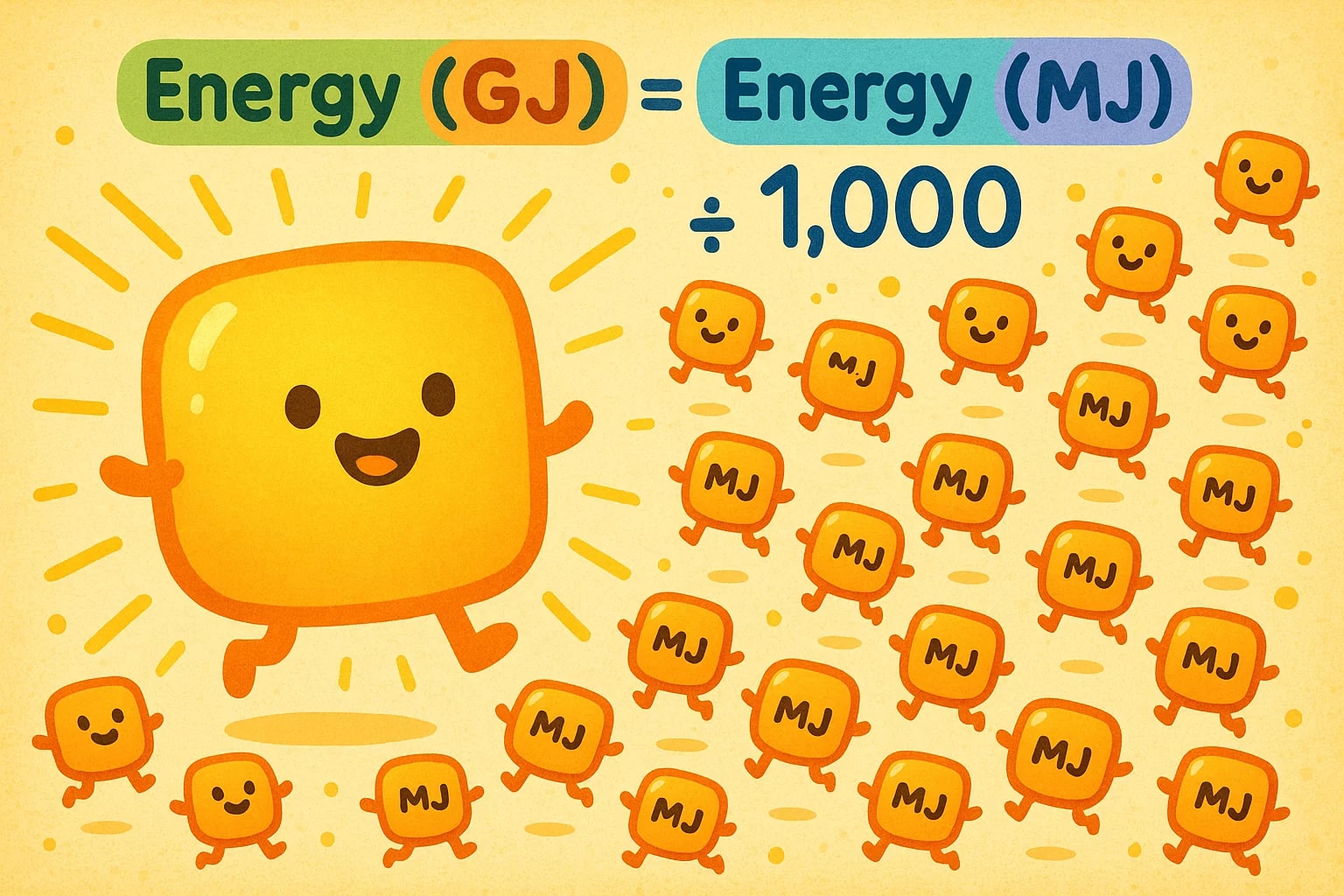gigajoule to megajoule – How to convert GJ to MJ
The conversion from gigajoule to megajoule is a straightforward step within the SI system, but it’s also a practical calculation for industries, researchers, and engineers.

What is a gigajoule?
A gigajoule (GJ) equals one billion joules. It’s often used to measure large-scale energy quantities such as industrial consumption, natural gas output, or the annual energy yield of a renewable power plant.
Formula:1 GJ = 1 000 MJ
or in joules:1 GJ = 10⁹ J
What is a megajoule?
A megajoule (MJ) equals one million joules. This unit appears in contexts like vehicle energy ratings, appliance specifications, and medium-scale energy projects.
Formula:1 MJ = 10⁶ J
How to convert gigajoule to megajoule
Since both units are from the SI system, conversion is direct:Energy (MJ) = Energy (GJ) × 1 000
Example: If you have 3.5 GJ, thenEnergy = 3.5 × 1 000 = 3 500 MJ
For the reverse:Energy (GJ) = Energy (MJ) ÷ 1 000
For quick, precise calculations, try our Energy Converter or explore more unit options with the full Conversion Tools collection.
Do you know?
-
Gigajoule fact: Many countries use gigajoules to bill for natural gas consumption. For example, in Canada, household heating bills often list monthly use in GJ.
-
Megajoule fact: In car safety tests, crash energy is sometimes expressed in megajoules to better compare vehicles’ energy absorption capacity.
-
Gigajoule fact: A typical wind turbine can generate 4–6 GJ of energy in just one hour under ideal conditions.
-
Megajoule fact: The energy released by burning one litre of petrol is about 34 MJ.
Solar Giants: Measuring a Farm’s Energy in GJ and MJ
In the Australian outback, a sprawling solar farm stretches across thousands of panels, feeding clean energy into the national grid. Over the course of a sunny summer’s day, the farm generates roughly 500 GJ of electricity — enough to power thousands of homes.
On the farm’s control screens, engineers view daily totals in gigajoules because the numbers remain manageable and easy to compare from day to day. But when they prepare technical maintenance reports, the same figures are converted to megajoules to align with equipment testing data and performance benchmarks.
Why? Megajoules allow finer granularity for analyzing efficiency. If one section of the solar field produces 125 000 MJ while another outputs 122 000 MJ under identical sunlight conditions, it signals a possible maintenance issue, such as dust accumulation or an inverter fault.
During one particularly windy week, output fluctuated wildly — the GJ totals seemed fine, but the MJ breakdown revealed small but consistent underperformance in a single row of panels. Technicians traced the issue to a loose cable, and repairs brought output back up immediately.
This practice of moving between GJ and MJ isn’t unique to solar farms. Hydroelectric stations, biomass plants, and even some large-scale industrial facilities use both units interchangeably, depending on whether they’re reporting to government agencies, conducting internal performance checks, or presenting results to investors.
The story of that solar farm shows why simple unit conversions can have real-world impact. Behind each number is a choice: how much detail is needed, and which unit makes the picture clearest?

Bridging GJ and MJ
Whether you’re monitoring renewable power output, calculating fuel energy, or analyzing industrial consumption, the gigajoule to megajoule conversion keeps your figures accurate and consistent. A difference of three zeros can be the difference between a quick overview and a detailed technical audit.
With the right tools, switching between them is effortless — and if your work spans multiple sectors, keeping both in your toolkit ensures clarity across every report.

